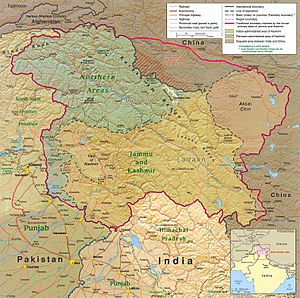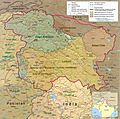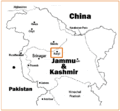Kashmir conflict facts for kids
Quick facts for kids Kashmir Conflict |
|||||||
|---|---|---|---|---|---|---|---|
|
India claims the entire erstwhile princely state of Jammu and Kashmir based on an instrument of accession signed in 1947. Pakistan claims Jammu and Kashmir based on its majority Muslim population, whereas China claims the Shaksam Valley and Aksai Chin. |
|||||||
|
|||||||
The Kashmir conflict is a dispute over the territory of Kashmir. The dispute is between India and Pakistan. India claims all of the region that was once a princely state. It currently controls about 43% of the territory, including most of Jammu, the Kashmir Valley, Ladakh, and the Siachen Glacier. India's claims are disputed by Pakistan, which controls about 37% of Kashmir, including Azad Kashmir and the northern areas of Gilgit and Baltistan. Pakistan says there should be a referendum in Kashmir on whether the people want to join India or Pakistan, or become independent.
History
The conflict started during the Partition of India (1947–48). On October 20, 1947, tribesmen backed by Pakistan invaded Kashmir. The Maharaja of Jammu & Kashmir initially fought back but on 27 October appealed for assistance to the Governor-General Louis Mountbatten, who agreed on the condition that the ruler accede to India. Once the papers of accession to India were signed, Indian soldiers entered Kashmir with orders to stop any further occupation, but they were not allowed to expel anyone from the state. India took the matter to the United Nations. The UN resolution asked Pakistan to vacate the areas it has occupied and asked India to assist the U.N. Plebiscite Commission to organize a plebiscite to determine the will of the people. Pakistan refused to vacate the occupied areas.
In 1947-8 India and Pakistan fought their first war over Jammu and Kashmir. Under United Nations' supervision, they agreed to a ceasefire along a line which left one-third of the state - comprising what Pakistan calls Azad Jammu and Kashmir, and the Northern Areas administered by Pakistan and two-thirds, Jammu, Ladakh and the Kashmir Valley, controlled by India. In 1972, under the terms of the Simla agreement, the ceasefire line was renamed the Line of Control.
Although India claims that the entire state is part of India, it has been prepared to accept the Line of Control as the international border, with some possible modifications. Both the US and the UK have also favoured turning the Line of Control into an internationally-recognised frontier.
But Pakistan has consistently refused to accept the Line of Control as the border since the predominantly Muslim Kashmir Valley would remain as part of India. Formalising the status quo also does not take account of the aspirations of those Kashmiris who have been fighting since 1989 for independence for the whole or part of the state.
Water dispute
Another reason behind the dispute over Kashmir is water. Many rivers start in Kashmir. Some of them are tributaries of the Indus River basin, such as the Jhelum and Chenab River. These flow into Pakistan and are used for irrigation there. Other rivers like the Ravi, Beas River and the Sutlej flow into northern India.
One of the origins of the conflict is that with the Boundary Award of 1947, many of the Pakistani irrigation systems can be controlled from India. Pakistan has been afraid that India could stop the flow of rivers that start in Indian-controlled Kashmir and flow into Pakistan. This would harm the agrarian economy of Pakistan. The Indus Waters Treaty signed in 1960 resolved most of these disputes over the sharing of water.
Current status
Today Kashmir is split, as follows:
- Republic of India controls the state of Jammu and Kashmir. It is made of the Jammu region, the Kashmir valley, and Ladakh. Pakistan refers to this as Indian occupied kashmir or Indian controlled kashmir, or Indian annexed kashmir and Indian held kashmir.
- The territories known as Northern Areas and Azad Jammu and Kashmir are administered by Pakistan. Islamabad calls them Pakistan-administered Kashmir. India refers to this as Pakistan-occupied Kashmir.
- The region called Aksai Chin is controlled by China. China also controls a territory it received from Pakistan, called Trans-Karakoram Tract. The legality of this swap is disputed by India.
- The Siachen Glacier is currently a disputed territory, India controls the glacier, Pakistan the valley below.
- The Trans-Karakoram Tract is an area Pakistan gave to China in 1963, March 3rd. Pakistan says the area was uninhabited, so there is no problem to this. India claims this area as part of its state Jammu and Kashmir.
Kashmir has been a flashpoint between India and Pakistan for more than 60 years. Currently a boundary - the Line of Control - divides the region in two, with one part military occupied by India and one administered by Pakistan. India would like to formalise this status quo and make it the accepted international boundary. But Pakistan and Kashmiri activists reject this plan because they both want greater control over the region.
Map issues
-
Map of UN's version of the South Asia region
-
Map of UN's version of the Kashmir region
-
Map of UN's version of the Republic of India and disputed areas
As with other disputed territories, each government issues maps depicting their claims in Kashmir as part of their territory, regardless of actual control. It is illegal in India to exclude all or part of Kashmir in a map. It is also illegal in Pakistan not to include the state of Jammu and Kashmir as disputed territory, as permitted by the UN. Non-participants often use the Line of Control and the Line of Actual Control as the depicted boundaries, as is done in the CIA World Factbook, and the region is often marked out in hashmarks, although the Indian government strictly opposes such practices. When Microsoft released a map in Windows 95 and MapPoint 2002, a controversy was raised because it did not show all of Kashmir as part of India as per Indian claim. However, all the neutral and Pakistani companies claim to follow the UN's map and over 90% of all maps containing the territory of Kashmir show it as disputed territory.
Images for kids
-
India claims the entire erstwhile British Indian princely state of Jammu and Kashmir based on an instrument of accession signed in 1947. Pakistan claims most of the region based on its Muslim-majority population, whereas China claims the largely uninhabited regions of Aksai Chin and the Shaksgam Valley.
-
The Instrument of Accession of Kashmir to India was accepted by the Governor General of India, Lord Mountbatten.
-
Sir Owen Dixon, UN mediator
-
Kashmir Solidarity Day on every 5 February is observed in Pakistan. This banner was hung in Islamabad.
-
Maharaja Hari Singh signed the Instrument of Accession in October 1947 under which he acceded the State of Jammu and Kashmir to the Union of India.
See also
 In Spanish: Conflicto de Cachemira para niños
In Spanish: Conflicto de Cachemira para niños















